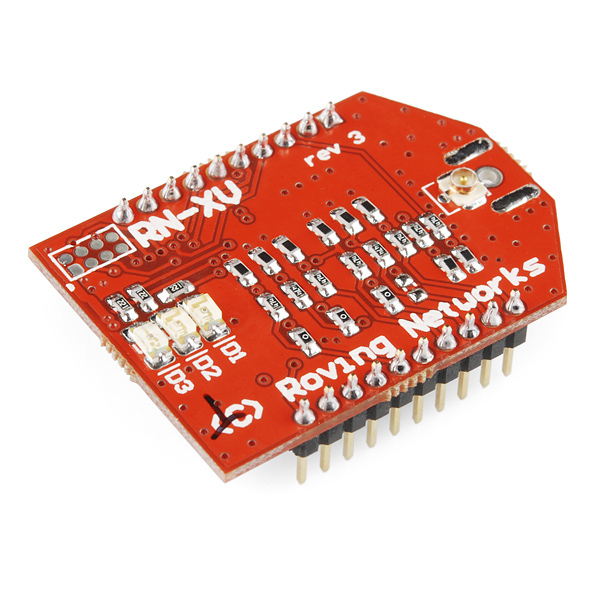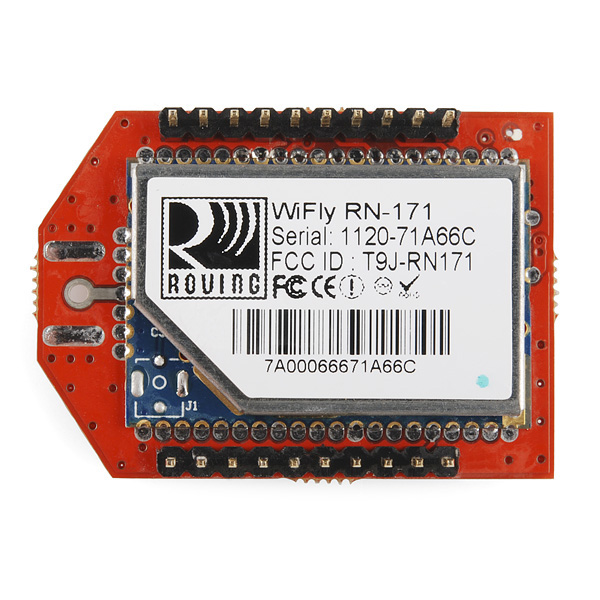RN-XV WiFly Module - U.FL Connector
The RN-XV module by Roving Networks is a certified Wi-Fi solution especially designed for customer who want to migrate their existing 802.15.4 architecture to a standard TCP/IP based platform without having to redesign their existing hardware. In other words, if your project is set up for XBee and you want to move it to a standard WiFi network, you can drop this in the same socket without any other new hardware.
The RN-XV module is based upon Roving Networks' robust RN-171 Wi-Fi module and incorporates 802.11 b/g radio, 32 bit processor, TCP/IP stack, real-time clock, crypto accelerator, power management unit and analog sensor interface.The module is pre-loaded with Roving firmware to simplify integration and minimize development time of your application. In the simplest configuration, the hardware only requires four connections (PWR, TX, RX and GND) to create a wireless data connection.
- Based on common 802.15.4 XBee footprint
- Ultra low power: 4uA sleep mode, 38mA active
- Onboard TCP/IP stack includes DHCP, UDP, DNS, ARP, ICMP, HTTP client, FTP client and TCP
- Firmware configurable transmit power: 0dBm to 12dBm
- Hardware interfaces:TTL UART
- Host data rate up to 464Kbps over UART
- Supports Adhoc and infrastructure networking
- 8 general purpose digital I/O
- 3 analog sensor inputs
- Real-time clock for time-stamping, auto-sleep, and auto-wakeup modes
- Accepts 3.3VDC regulated power supply
- U.FL connector
RN-XV WiFly Module - U.FL Connector Product Help and Resources
Core Skill: Electrical Prototyping
If it requires power, you need to know how much, what all the pins do, and how to hook it up. You may need to reference datasheets, schematics, and know the ins and outs of electronics.
Skill Level: Rookie - You may be required to know a bit more about the component, such as orientation, or how to hook it up, in addition to power requirements. You will need to understand polarized components.
See all skill levels
Comments
Looking for answers to technical questions?
We welcome your comments and suggestions below. However, if you are looking for solutions to technical questions please see our Technical Assistance page.
Customer Reviews
4 out of 5
Based on 1 ratings:
1 of 1 found this helpful:
wifi connection works, setup is a bit of a hassle
Download "wifly command reference" from microchip. Practice with a terminal program (9600N81) with local echo so you see both the command and the response. "get wlan" "get ip" and "get everything" are good commands. Don't forget the $$$ to get into CMD mode.
Update to 4.41, both .img and .mif and "run web_app" to enable soft AP mode. FTP server address is 198.175.253.161.
I'm using it to post temperature data to a web server. This works very well.





Does it works without antenna??
Cool! do i need and extra antenna?
This does not have an antenna included on it. See the related products for the U.FL adapter and matching antennas.
I'm not too familiar with WiFi protocols and whatnot... but could this be used to communicate with a WiFi-enabled laptop? How about a smartphone? Thanks
Yes, that's the beauty of WiFi. On the laptop or smart phone you have to have an App that will connect to it... so anything custom you will have to write yourself.
However, a quick and dirty way to get some communication going is to run a Telnet App (Freely downloadable) on the laptop or smartphone and use that to connect to the module.
The Roving Networks modules insulate the Arduino (Or whatever you connect it to) from the TCP/IP stack, data is just sent and received serially through the UART on the module.
Thanks! So the result would be a straight-up serial-type connection, from the Telnet App to the Arduino? Or is there a more complex protocol involved?
CAn we communicate between two rn xv modules and laptop or pc???
About 6 months ago I ordered/got a RN-XV WiFly Module (WRL-11048) but was busy and until last night had not opened it. with much excitement to make use of WiFi and Arduino I cracked it open and soldering on 4 leads: Pin 1 - Power 3.3, Pin 2 - RX, Pin 3 - TX and Pin 10 GND... no problem easy enough with soldering paste, helping hands and a magnifier.
I weird it up to the Arduino and upon powering it I see my RX/TX LED's go nuts and my PC thinks I have disconnected the USB. I inspect the soldering job with microscope and things look just fine..
NOTE: I do not need to connect the rx/tx to make it go nuts, Only ground and 3.3 power.
Any ideas here as to why my RX/TX LED would go crazy..
Some pics of the leads/soldering job and wire up. - ( Leads) - http://www.9screws.com/images/WiFly2.jpg - (Wire up)- http://www.9screws.com/images/WiFly1.jpg
Thanks for any help on this!
When you 'weird it up', the expected behavior is to 'go nuts' and 'go crazy'. Not sure why you would expect another result.
I don't have the TX/RX hooked up and the lights still go crazzy/nuts and my PC thinks I have disconnected USB.
I would suggest using a genuine Arduino product. Knock-offs have unexpected behaviors. In the picture from the link you posted above, the web address on the board should be arduino not arduion. There should be a "Made in Italy" declaration top-left on the board near the USB port.
ur rx and tx are both 5v on the board im guessing and the wifly needs 3.3 commsignals etc.
may I know how much you paid for? :)
I love this device. I just received it and within 10 minutes I was up and running my own AdHoc WiFi network, viewing data on my WiFly connected FEZ Cerbunio Bee from the browser.
Next I want to setup the WiFly to automatically transmit data on the sensors via WiFi/HTTP to a listening server. This works fine in the FEZ Cerbuino Bee, but when I try the WiFly alone, with only power and ground connected, it connects every 5 seconds to my HTTP server but it doesn't post any data (aside from the HELLO I set as the static connection greeting).
Any ideas? Do I need more than power and ground connected to run the WiFly all by itself?
Do i need an extra component for programming and mount at breadboard?
Can you drop this into an Arduino Fio's Xbee socket without much hassle?
Hi, i just bought wifly rn-171 module but couldn't distinguish which pin represent what, anyone has a link to easy to understand diagram, where it say which pin represent grn, rx, and so on?? or how can i identify it??
Has anyone ever used these with a Ubiquiti PicoStation M2HP (or NanoStation Loco M2)? It works great with my ASUS, but I'm thinking about setting up WiFi to cover an acre in which case I'll probably go all Ubiquiti.
Update, for anyone looking at Ubiquitis products: PicoStation M2HP came a week ago, finally got a chance to test the 2 together and didn't have a problem. I don't know how strong of signal the RN-XV sees but the PicoStation sees -52dBm from the RN-XV and it's outside by the garden ~100 ft away with a little rubber duck antenna, so the RN-XV probably sees ~-40dBm. If I went with the NanoStation Loco it would be stronger due to the directional antenna but not as useful for multipoint. On a side note, Ubiquitis AirOS is amazing, AirView tool(spectrum analyzer) made it easy to find the least used channel and is more helpful than a standard site survey.
What is the range of this module? can you use just 2 of these standalone, like xBees?
At power up, using TeraTerm, I am getting WiF,WiF,WiF,WiF,WiF,WiF,WiF,WiF, streaming in. And I type $$$ and nothing changes just get the WiF,WiF,WiF, coming in non stop.. What can be causing this?
Are you using 9600 baud?
I have a similar problem. I see it talking but get no response to $$$. Did you manage to resolve this?
Hmm, did u type $$$ followed by return or just type $$$? I'm guessing you tried the latter, but it's worth asking? :]
According to the users' manual:
This device generates the TCP/IP stack correct? Which leads me to assume that it is not restricted to WiFi "Hotspots" and can be used anywhere?
That is correct, it can be set up to run independently of a AP in adhoc mode. For instance, battery operated WiFly and laptop or smartphone in the middle of a cornfield 20 miles from the nearest hotspot and you can get real time sensor readings or communications with the module.